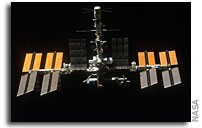NASA Space Station Lead Increment Scientist’s Highlights For the Week of July 23, 2012

(Highlights: Week of July 23, 2012) — More than 5,000 students from around the world participated in the latest session for the Earth Knowledge Acquired by Middle School Students (EarthKAM). Students used the onboard EarthKAM camera in the Window Observational Research Facility (WORF) to take Earth observation photos. WORF is a facility equipped with Earth science remote sensing instruments in the Destiny science window with the highest quality optics ever flown on a human-occupied spacecraft. EarthKAM is a NASA education program that offers a powerful way for students to investigate Earth from the unique perspective of space. The image collection is posted on the EarthKAM website for both public use and participating classrooms around the world. More than 1,400 images were captured during this session.
More tests were successfully completed for the Burning And Suppression of Solids (BASS) investigation. BASS examines the burning and extinction characteristics of a wide variety of fuel samples in microgravity. A crew member conducted flame tests at various air flow speeds and sample widths. These tests were run to determine if the flames would blow out at high flow rates. The BASS investigation will guide strategies for extinguishing accidental fires in microgravity. BASS results contribute to the combustion computational models used in the design of fire detection and suppression systems in microgravity and on Earth.
Fifteen tests were conducted with the Synchronized Position Hold, Engage, Reorient, Experimental Satellites, or SPHERES. The data will allow the team to verify the new mass properties and aid in the development of the SPHERES Zero Robotics competition later this year. The main objectives of this session included characterizing new mass properties of the satellite with the recently installed expansion port, testing parts of the Zero Robotics code to be used later this year as part of a high school competition, and conducting research in the areas of orbital dynamics and visual inspection.
Tests with the DEvice for the study of Critical LIquids and Crystallization Alice Like Insert (DECLIC-ALI) were dedicated to the observation of the boiling process when increasing the temperature. DECLIC-ALI studies liquids at the verge of boiling. The flow of heat during boiling events is different in microgravity than it is on Earth. Understanding how heat flows in fluids at the verge of boiling will help scientists develop cooling systems for use in microgravity. On Earth, the readily variable properties of near-critical fluids makes them appealing candidates for studying numerous interesting phenomena valid for all fluids, which will ultimately lead to the development of improved solvents for chemistry and the environment.
Thirteen runs have been completed for the Japan Aerospace Exploration Agency-sponsored Chaos, Turbulence and its Transition Process in Marangoni Convection (Marangoni). This is one of two physics experiments analyzing the behavior of a surface-tension-driven flow in microgravity.
Human research investigations continued for various crew members including, Space Headaches, ALTEA Shield, Journals, Treadmill Kinematics, Integrated Cardiovascular, Pro K, Nutrition and Reaction Self Test .








